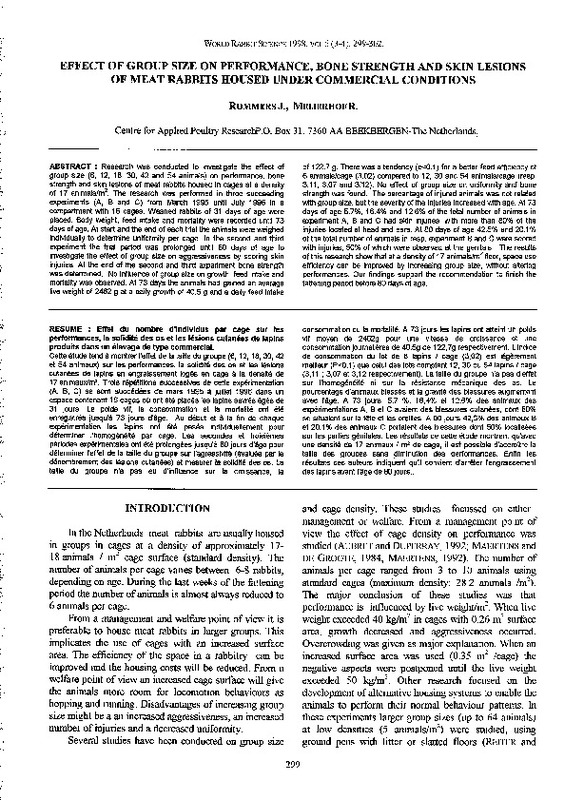JavaScript is disabled for your browser. Some features of this site may not work without it.
Buscar en RiuNet
Listar
Mi cuenta
Estadísticas
Ayuda RiuNet
Admin. UPV
EFFECT OF GROUP SIZE ON PERFORMANCE, BONE STRENGTH AND SKIN LESIONS OF MEAT RABBITS HOUSED UNDER COMMERCIAL CONDITIONS
Mostrar el registro sencillo del ítem
Ficheros en el ítem
| dc.contributor.author | ROMMERS, J.
|
|
| dc.contributor.author | MEIJERHOF, R.
|
|
| dc.date.accessioned | 2011-03-14T12:13:56Z | |
| dc.date.available | 2011-03-14T12:13:56Z | |
| dc.date.issued | 1998 | |
| dc.identifier.issn | 1257-5011 | |
| dc.identifier.uri | http://hdl.handle.net/10251/10322 | |
| dc.description.abstract | [EN] Research was conducted to investigate the effect of group size (6, 12, 18, 30, 42 and 54 animals) on performance, bone strength and skin lesions of meat rabbits housed in cages at a density of 17 animals/m2 . The research was performed in three succeeding experiments (A, B and C) from March 1995 until July 1996 in a compartment with 16 cages. Weaned rabbits of 31 days of age were placed. Body weight, feed intake and mortality were recorded until 73 days of age. At start and the end of each tria! the animals were weighed individually to determine uniformity per cage. In the second and third experiment the tria! period was prolonged until 80 days of age to investigate the effect of group size on aggressiveness by scoring skin injuries. At the end of the second and third experiment bone strength was determined. No influence of group size on growth, feed intake and mortality was observed. At 73 days the animals had gained an average live weight of 2462 g at a daily growth of 40.5 g and a daily feed intake of 122.7 g. There was a tendency (p<0.1) for a better feed efficiency of 6 animals/cage (3.02) compared to 12, 30 and 54 animals/cage (resp. 3.11, 3.07 and 3:12). No effect of group size on uniformity and bone strength was found. The percentage of injured animals was not related with group size, but the severity of the injuries increased with age. At 73 days of age 5.7%, 16.4% and 12.6% of the total number of animals in experiment A, B and e had skin injuries, with more than 80% of the injuries located at head and ears. At 80 days of age 42.5% and 20.1 % of the total number of animals in resp. experiment B and C were scored with injuries, 50% of which were observed at the genitals. The results of this research show that at a density of 17 animals/m2 floor, space use efficiency can be improved by increasing group size, without altering performances. Our findings support the recommendation to finish the fattening period before 80 days of age. | es_ES |
| dc.description.abstract | [FR] Cette étude tend a montrer l'effet de la taille du groupe (6, 12, 18, 30, 42 et 54 animaux) sur les performances, la solidité des os et les lésions cutanées de lapins en engraissement logés en cage a la densité de 17 animaux/m2• Trois répétitions successives de cette expérimentation (A, B, C) se sont succédées de mars 1995 a juillet 1996 dans un espace contenant 16 cages ou ont été placés les lapins sevrés agés de 31 jours. Le poids vif, la consommation et la mortalité ont été enregistrés jusqu'a 73 jours d'age. Au début et a la fin de chaque expérimentation les lapins ont été pesés individuellement pour déterminer l'homogénéité par cage. Les secondes et troisiémes périodes expérimentales ont été prolongées jusqu'a 80 jours d'age pour déterminer l'effet de la taille du groupe sur l'agressivité (évaluée par le dénombrement des lésions cutanées) et mesurer la solidité des os. La taille du groupe n'a pas eu d'influence sur la croissance, la consommation ou la mortalité. A 73 jours les lapins ont atteint un poids vif moyen de 2462g pour une vitesse de croissance et une consommation journaliéres de 40,5g de 122,7g respectivement. L'indice de consommation du lot de 6 lapins / cage (3,02) est légérement meilleur (P<O, 1) que celui des lots comptant 12, 30 ou 54 lapins I cage (3, 11 ; 3,07 et 3, 12 respectivement). La taille du groupe n'a pas d'effet sur l'homogénéité ni sur la résistance mécanique des os. Le pourcentage d'animaux blessés et la gravité des blessures augmentent avec rage. A 73 jours, 5,7 %, 16,4% et 12,6% des animaux des expérimentations A, B et e avaient des blessures cutanées, dont 80% se situaient sur la téte et les oreilles. A 80 jours 42,5% des animaux B et 20, 1 % des animaux C portaient des blessures dont 50% localisées sur les parties génitales. Les résultats de cette étude montrent qu'avec une densité de 17 animaux I m• de cage, il est possible d'accroTtre la taille des groupes sans diminution des performances. Enfin les résultats des auteurs indiquent qu'il convient d'arréter l'engraissement des lapins avant rage de 80 jours .. | |
| dc.language | Inglés | es_ES |
| dc.publisher | World Rabbit Science. ICTA. UPV | es_ES |
| dc.relation.ispartof | World Rabbit Science | |
| dc.rights | Reserva de todos los derechos | es_ES |
| dc.title | EFFECT OF GROUP SIZE ON PERFORMANCE, BONE STRENGTH AND SKIN LESIONS OF MEAT RABBITS HOUSED UNDER COMMERCIAL CONDITIONS | es_ES |
| dc.type | Artículo | es_ES |
| dc.date.updated | 2011-03-14T11:49:58Z | |
| dc.identifier.doi | 10.4995/wrs.1998.360 | |
| dc.rights.accessRights | Abierto | es_ES |
| dc.description.bibliographicCitation | Rommers, J.; Meijerhof, R. (1998). EFFECT OF GROUP SIZE ON PERFORMANCE, BONE STRENGTH AND SKIN LESIONS OF MEAT RABBITS HOUSED UNDER COMMERCIAL CONDITIONS. World Rabbit Science. 6(3-4). https://doi.org/10.4995/wrs.1998.360 | es_ES |
| dc.description.accrualMethod | SWORD | es_ES |
| dc.relation.publisherversion | https://doi.org/10.4995/wrs.1998.360 | |
| dc.description.volume | 6 | |
| dc.description.issue | 3-4 | |
| dc.identifier.eissn | 1989-8886 | es_ES |








